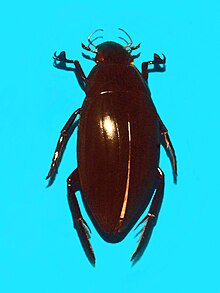Hydrophilus piceus
| Hydrophilus piceus | |
|---|---|
 |
|
| Scientific classification | |
| Kingdom: | Animalia |
| Phylum: | Arthropoda |
| Class: | Insecta |
| Order: | Coleoptera |
| Family: | Hydrophilidae |
| Genus: | Hydrophilus |
| Species: | H. piceus |
| Binomial name | |
|
Hydrophilus piceus (Linnaeus, 1758) |
|
| Synonyms | |
|
|
Hydrophilus piceus is a species of beetles in the family Hydrophilidae, the water scavenger beetles. It is known by the common name great silver water beetle.
This beetle is among the largest aquatic insects. It can exceed 5 centimeters in length and 2 centimeters in width; the head alone can be a centimeter long. The body is black with a greenish or olive sheen. It has protruding eyes and reddish-black antennae.
This beetle lives in aquatic environments. In some regions it can be found in lakes and ponds. In Greece it can be found in lagoons and estuaries. It has been found at elevations of up to 1000 meters. In Great Britain it lives in ditches with thick vegetation in marshy areas.
The beetle is omnivorous but favors plant material. It can live for up to 3 years but most individuals die after breeding during their first year. The larvae feed on freshwater snails of the family Lymnaeidae, drilling holes into the shells to feed on the animals. The grubs can then reach 7 centimeters long before pupating in the mud. In the spring, the adult female spins a cocoon, fills it with eggs, and sets it afloat.
This beetle is native to the Palearctic ecozone, where it occurs throughout much of Eurasia, its distribution extending from Scandinavia to the Mediterranean, North Africa, and Russia, and as far east as India. Its distribution is not continuous because it has been extirpated from some areas; it is considered to be extinct in Norway and Luxembourg, for example. It is rare in some regions, being found only in specific and relictual habitat types.
...
Wikipedia
